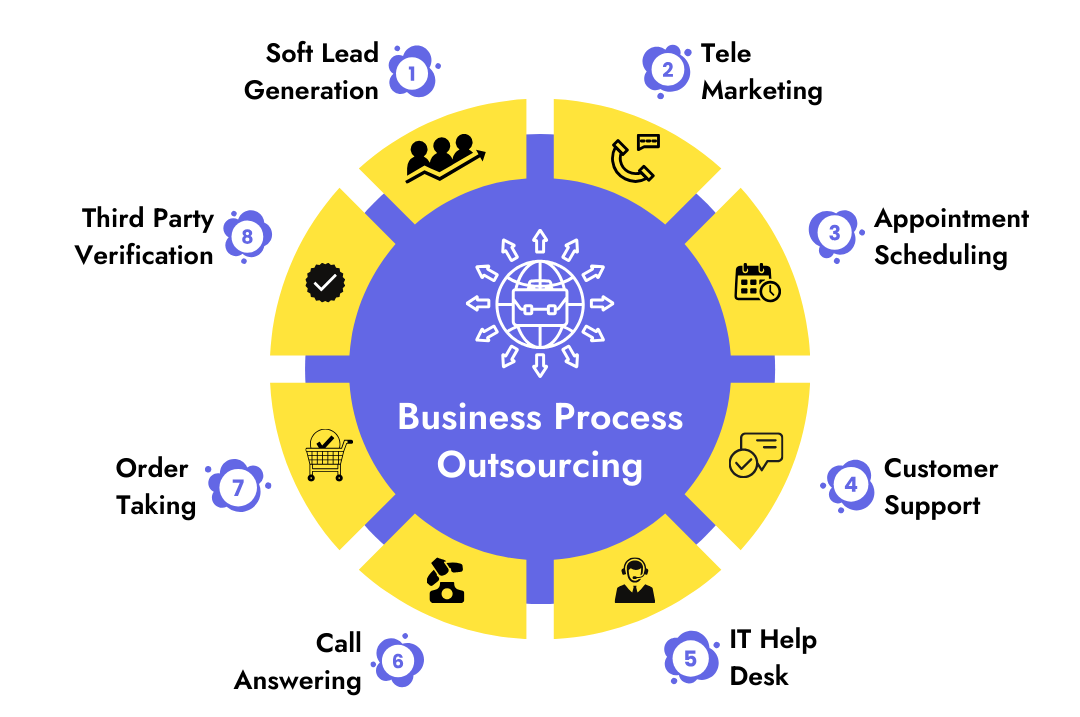In the dynamic realm of modern enterprises, maintaining a competitive edge remains a top priority. To succeed in this era of digital transformation, organizations must embrace innovative technologies that enhance efficiency, trim operational costs, and elevate customer satisfaction.
Among these technologies, Robotic Process Automation (RPA) stands out as a crucial tool for a specific sector: Business Process Outsourcing. But what exactly makes RPA an indispensable asset for contemporary BPO providers?
In this blog post, we’ll explore the compelling reasons behind RPA’s pivotal role in revolutionizing the way BPO services are delivered and why it has become a must-have in this industry. Let’s embark on this journey to uncover the transformative power of RPA for modern BPO providers.
Understanding the Essentials: RPA and BPO
In our journey to grasp why RPA is indispensable for modern BPO providers, let’s begin by understanding the key components:
Robotic Process Automation (RPA) is a technology that has taken the business world by storm. At its core, RPA involves the use of software robots or “bots” to automate repetitive and rule-based tasks within various business processes. The beauty of RPA lies in its accessibility; you don’t have to be a programming expert to leverage its capabilities! These bots are designed to be user-friendly, allowing professionals to create automation scripts through intuitive interfaces. RPA brings a new level of efficiency to organizations, enabling them to free up human resources from mundane tasks, reduce errors, and ensure round-the-clock availability for critical processes.
Business Process Outsourcing (BPO), on the other hand, is a strategic practice where companies delegate specific business functions or processes to external service providers. This outsourcing allows organizations to focus on their core competencies while relying on experts to handle non-core functions. BPO encompasses a wide range of services, including customer support, finance and accounting, human resources, and more. It has become a cornerstone of modern business strategies, offering cost savings, scalability, and access to specialized skills.
In light of how BPO services have become increasingly instrumental across various industries, the appeal of integrating RPA is readily apparent. RPA stands as a well-established technology already prevalent in many sectors, making it a compelling choice for service providers. Consequently, within services ranging from finance to customer support, RPA’s proven track record of success renders it an invaluable and captivating technology for BPO service providers to embrace.
What are the types of Business Process Outsourcing?

According to a report, 66% of businesses with more than 50 employees invest in outsourced services, while only 29% of enterprises with 50 or fewer staff allot a budget for external support in their operations.
Before we dive into how Robotic Process Automation is transforming Business Process Outsourcing, let’s take a closer look at the different types of BPO. Think of these as different ways businesses get help from outside experts to make things run smoother.
What are The Benefits of Using RPA in BPO?
In this section, we will examine the practical advantages that RPA offers when it becomes a part of Business Process Outsourcing. RPA is more than just a tool; it brings substantial changes to how BPO providers work and provide services. Here are the specific advantages of integrating RPA into BPO operations, shedding light on its transformative impact on the industry.
Enhancing Productivity and Precision
Undoubtedly, the incorporation of Robotic Process Automation into Business Process Outsourcing operations leads to a notable transformation in productivity and accuracy. It’s a game-changer in terms of getting work done efficiently and precisely.
RPA bots tirelessly perform routine, rule-based tasks with unwavering precision. They don’t experience fatigue or distractions, which often affect human workers. Consequently, the speed and consistency with which these tasks are executed are unparalleled. This heightened efficiency translates to BPO operations completing tasks more swiftly and reliably than ever before.
By relieving human workers of repetitive, time-consuming duties, RPA allows them to concentrate on tasks that require critical thinking and creativity. This shift in focus not only elevates the overall quality of work but also enhances the value-added services that BPOs can offer to their clients. In essence, RPA in BPO acts as a catalyst for achieving peak productivity and maintaining impeccable accuracy.
Improving Work Quality
In BPO, it’s super important that the work is always good and accurate. But sometimes, people can make mistakes or do things a little differently. With RPA, robots follow the rules exactly, so they do the tasks really, really accurately. This means there are fewer mistakes, and the work is always the same, which is super important.
RPA also helps follow all the rules and policies, which is really crucial in BPO. Clients like this because they know the work will always be good. So, when we use RPA in BPO, it’s not just about making things faster; it’s about making sure the work is top-notch every time.
Flexibility and Scalability
In the world of BPO, workloads can go up and down. Sometimes there’s a lot to do, and other times it’s quieter. RPA helps us deal with these changes smoothly. We can use more robots when there’s lots to do, and we can reduce them when there’s less. This means RPA robots can always handle the work efficiently, no matter how much there is. This adaptability is a huge advantage. It lets BPO companies be super flexible and provide consistent services even when things change.
What are The Different Use Cases for RPA in BPO?
Customer Service
The most significant way RPA is used in the BPO industry is within customer service. Nowadays, most customers want their questions answered quickly.
RPA can make the process faster by following a set of rules to gather more information about what customers need, providing self-help solutions, or connecting them to the next available customer service agent after collecting the necessary details.
In customer service, RPA bots can start the conversation with customers, making it easy for them to get help. It’s interesting to note that RPA can automate a big chunk of the processes in customer service – around 70 to 80% of them (Towards Data Science).
Invoice Processing
In a BPO firm handling diverse client needs, the challenge of processing invoices from various formats and sources was causing significant delays and errors. Implementing RPA transformed this cumbersome process. RPA bots were programmed to swiftly extract data from invoices, cross-reference it with purchase orders, and follow customized approval workflows. This not only accelerated invoice processing, but also reduced errors to near-zero levels.
Data Entry & Validation
In the modern era, data presents itself in diverse forms, ranging from machine-readable digital information to handwritten notes, encompassing a wide spectrum of data types that data professionals encounter daily. As a consequence, the entire workflow involving data comprehension, data entry, and data validation often poses significant challenges for data entry professionals. RPA empowers businesses to alleviate the burdens associated with data entry and validation tasks by automating these processes with exceptional precision.
Price Comparison
RPA in BPO is widely used for price comparison, a critical task for businesses procuring goods in bulk. Manual comparisons are time-consuming and costly, prompting many businesses to adopt RPA for this task. This automated system efficiently evaluates various vendors for quality, reliability, and pricing, delivering optimal results and helping businesses make informed, cost-effective procurement decisions.
Reconciliation
Reconciliation, which entails organizing and verifying expenditure data and balances, can be a time-consuming task when done manually within the Accounts department. This valuable time could be allocated more effectively elsewhere.
RPA comes to the rescue by automating the matching and sorting of payment details, thus streamlining the reconciliation process and ensuring a more efficient and accurate record-keeping experience for organizations.
The mentioned RPA use cases are only a glimpse of its widespread applications in Business Process Outsourcing. RPA robots have few limitations, and these are continually decreasing due to advancements in artificial intelligence technology. The success of Robotic Process Automation is evident across various industries, making it a valuable asset for many service-oriented BPO organizations.
References
“The Impact of RPA in BPO | Nanonets Blog.” Nanonets Intelligent Automation, and Business Process AI Blog, 26 May 2022, nanonets.com/blog/rpa-in-bpo/. Accessed 26 Sept. 2023.
Utermohlen, Karl. “All the Robotic Process Automation (RPA) Stats You Need to Know.” Medium, 7 Apr. 2018, towardsdatascience.com/all-the-robotic-process-automation-rpa-stats-you-need-to-know-bcec22eaaad9.
Mace, Nicola. “Global Outsourcing Statistics That Matter to Businesses.” OptiBPO, 22 Nov. 2021, optibpo.com/blog/global-outsourcing-statistics-that-matter-to-businesses/?ref=nanonets.com#:~:text=The%20market%20value%20for%20global. Accessed 26 Sept. 2023.
Nguyen, Andy. “10 Outsourcing Statistics Every Organization Should Know.” Time Doctor Blog, 10 Sept. 2019, www.timedoctor.com/blog/outsourcing-statistics/. Accessed 26 Sept. 2023.



